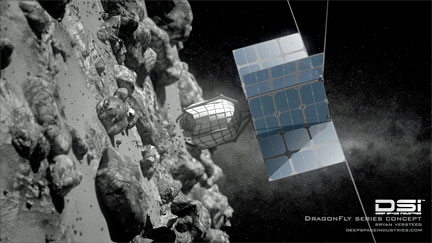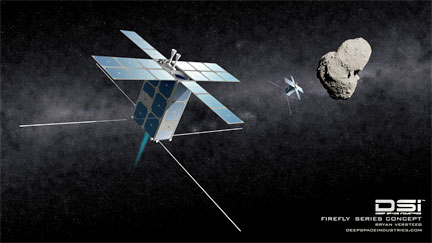...do things a new way in space, says Deep Space Industries. NASA’s asteroid plans, if coupled with private sector initiatives, will be a great start to understanding both the threat and promise of space objects—saving taxpayer funds while also helping kick start a new U.S.-led commercial space industry.

Artistic concept image of DSI's DragonFly series spacecraft.
For example, finding and understanding which asteroids should be candidates for such a project can be done relatively cheaply, if private groups and companies are involved. Deep Space Industries believes the commercial space resources industry can provide key insights on which targets offer the most potential for accelerating space development, and how they can be returned at the lowest cost with NASA as the customer rather than the operator of missions.
“The recent Keck Institute study suggested tracking down a free-orbiting 22-foot rock and stuffing it into a bag,” said Deep Space Industries CEO David Gump. “The B612 Foundation’s plan to place telescope inside the Earth’s orbit would be a good way to begin looking for such an object. However, before we send out an expensive NASA robotic mission to do the ’tag and bag‘, we need to be sure that what telescopes have seen is not a much smaller asteroid that is very bright, or a much bigger one that is very dark – and that means prospecting up close first – something we can do much cheaper, better and faster than the government.”

Artist's concept image of DSI's FireFly spacecraft.
NASA should partner with commercial asteroid companies to first create a prospecting campaign that visits potential targets and identifies the best technologies for retrieving them, before committing its money to the free-floating rock-in-a-bag approach says Deep Space, whose small FireFly class missions are planned for as early as 2015 at a cost of just a few million dollars each.
“Our notebook of asteroid knowledge has many blank pages,” said DSI Chief Scientist Dr. John S. Lewis, author of the authoritative asteroid books Rain of Iron and Ice and Mining the Sky. “NASA solved a similar problem for the Apollo program by sending a series of small and relatively inexpensive robotic precursors, starting with Pioneer flybys, Ranger high-speed impactors, Lunar Orbiter mapping surveys, and Surveyor landers. Such a phased robotic program is just what is required now – except this time we can make sure our investment enables much more than flags and footprints.”

